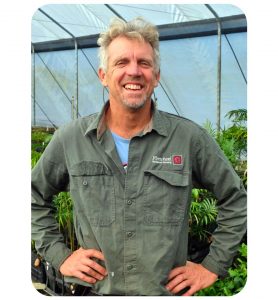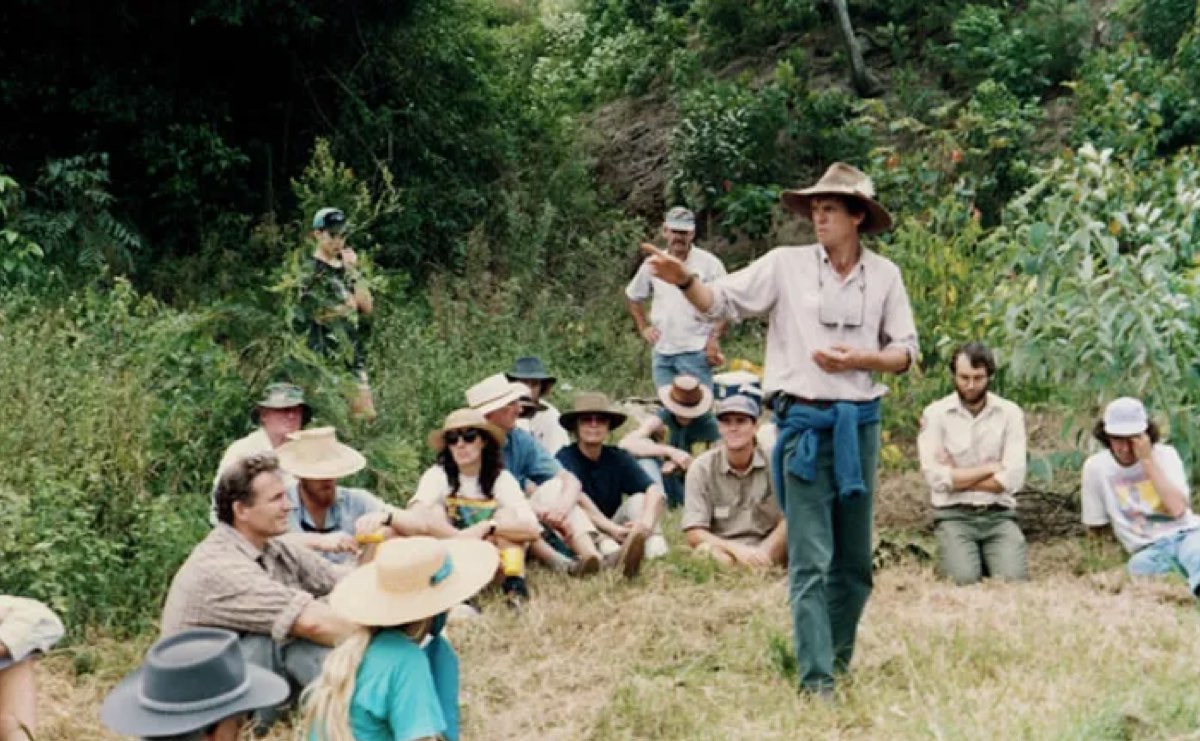Experience Mark Dunphy’s Daintree Journey
We are so excited to have Mark Dunphy, author, ecologist, founder of the Firewheel Rainforest Nursery, and president of Big Scrub Rainforest Conservancy (BSRC), share his memories of the Daintree with you today, in the latest from our series of 25th anniversary messages.
Mark’s tireless work in restoring the Big Scrub Rainforest – a place where only 1% of its original footprint remains, although at long last this number is increasing – along with Dr Tony Parkes and the Far North Coast ecological restoration movement has many parallels with Rainforest Rescue’s journey.
In fact, the Firewheel Rainforest Nursery is the blueprint for our Cow Bay Native Nursery that will soon grow 150,000 trees a year. Mark is our Nursery Advisor, consulting with Marine, Hayden and the team on propagation and growth techniques that mimic natural biodiversity development when restoring degraded land.
Over to you Mark…
Hitchhiking to Heaven
“My first connection to the Daintree was when I hitchhiked from northern NSW to Cape Tribulation in 1981.
I camped on the beach with the other hippies and hitchhiked along the Daintree ‘road’, through the causeways that flooded and we nearly got washed away!
This was at the time where the road just stopped and then it was dense rainforest. There was one shop where you could actually get some food. We were hanging about, you know, and I think to myself ‘Oh my God, I’m in the jungle. I’m in heaven here.’
This was a time before the subdivision of the lowland rainforest. Before the Daintree Blockade, before the need for buyback and protecting what was so easy to lose.
I realised that the Daintree is the ‘Holy Grail’ of rainforest habitat.
It’s like in heaven where everything grows all the time. The canopy forms in half of the time (compared to subtropical rainforest) in the tropics.
Wildlife like Southern cassowary and Bennett’s Tree Kangaroo, there are all these iconic species around you up here. You’ve got massive diversity in the flora and fauna, and, at the time (over 40 years ago), you’ve got a massive amount of rainforest.
When I was last in the Daintree I trekked deep into it and observed the plants that were previously believed to be extinct – Idiospermum.
This is one of the ultimate iconic plant species. It had disappeared from records, and it’s come back. It’s got a huge fruit, somewhat like a black bean, which has a stem coming up through the middle of it when it germinates. They are cassowary food, and they are also ancient, a prehistoric plant species.
Then, and it’s almost a cliche because they are so visually iconic, the Daintree also has plants like the native Queensland fan palms (Licuala ramsayi). I’m crazy about them! They’re stunning. You walk through a fan palm gallery, and they are so wonderful to see that you want to share the experience with everyone.”
From Conservation to Restoration
“The great Leonard (Len) Webb was a botanist and huge inspiration to me, mentoring people that I worked with in rainforest ecology.
Back in the 1990s, we were sucking up information and then going out into the field to apply what we were learning. Between us we’d defined some of the models about how to grow rainforest from scratch. Which meant rainforest restoration was possible.
Within the ecological community, the practices spread as rainforest restoration started to take off. My modus operandi with Firewheel is to make sure that restoration works across the board. Skills in the field, skills in the nursery, and the capability to successfully restore and reconnect existing remnants of rainforest with the right trees in the right place at the right time. That way, we’re all achieving a quality which benefits the rainforest biodiversity. Rather than a handful of species that struggle to reach maturity.
This restoration standard is what Rainforest Rescue is utilising. We’ve worked with Marine and the team to optimise propagation techniques for more effective growth in the new nursery.
The Daintree is the ultimate diverse tropical rainforest of Australia and contains globally significant plant records. It contains an amazing diversity of plant and animal species, many of which are dependent on these forests for survival.
If I took someone to the Daintree, we would visit Nightwings Rainforest Centre. There they can witness how the restoration corridors join together remnants and create new rainforest growth.
For me, I’ve seen how Rainforest Rescue has helped to preserve what remains of the Daintree, but now the priority is to expand and then connect. And that’s exactly what they’re doing.
This process can happen so fast. When I last visited, I could already identify animals were moving into a recently regenerated area. After about four or five years the natural regeneration coming from the existing forest takes over. This gives you huge value for money because of the regeneration speed that comes from a tropical climate.
So, if you have the land and the capacity and the trees you could ramp up quickly. You’d be outstripping anybody else in Australia for rainforest restoration, that’s for sure.”

Want more good Rainforest news in your life?
Subscribe to our eNews | Follow us on Instagram | Like us on Facebook | Subscribe to our YouTube channel
Help Protect Rainforests Forever
Donate to Protect Rainforests Forever | Become a Rainforest Guardian for as little as $2 a month | Partnership Options




